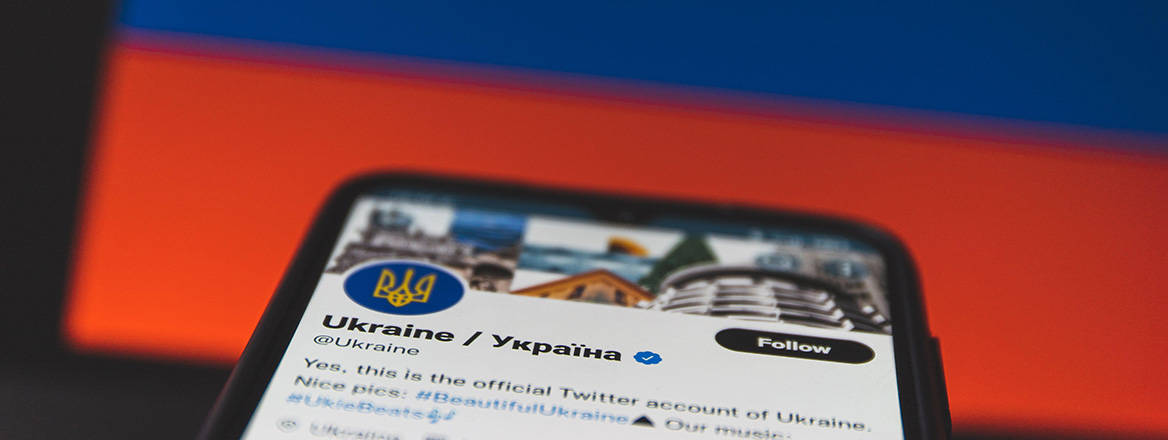The Tweet is Mightier than the Sword: Debunking Disinformation in Ukraine
Social media reporting of the war in Ukraine has allowed a global audience to readily engage with the conflict through access to a mass of information. However, given the sheer quantity of reporting available, both real and forged, how effectively have Ukraine and Russia managed information warfare, and is it realistically possible to own the narrative in this digital age?
For years, Russia has conducted a highly effective ‘firehouse of falsehood’, spreading disinformation to sow fear. This has been achieved through a mix of overt and covert military, paramilitary and civilian organisations, including state-owned media outlets such as Sputnik, RT and the Internet Research Agency, once described as ‘the biggest trolling operation in history’. These outlets are underpinned by other long-standing influence tools such as illicit financing, exploitation of trade dependencies such as gas and oil, and corruption. Examples of Russian interference are well-known, but rarely proven. Russia has been blamed for influencing the 2016 US election, Brexit, cyber attacks and assassination attempts; influence activity has allowed President Vladimir Putin and Russia to achieve an illusion of superiority. The prevailing tendency of seeing Putin as a Machiavellian grand-mastermind plays to a Western fear that he is behind everything that goes wrong, and that each setback is part of some complex Russian strategy.
A Russian Tradition?
It is within this space of disinformation that Russia, and the Soviet Union before it, has traditionally excelled. Prior to the Ukraine conflict, Putin had expertly manoeuvred, manipulating fear and instilling a political paralysis in the international arena; this is an excellent example of how information activity can contribute to deterrence. ‘To the West, Putin looks active, assertive, aggressive, a warrior Tsar at the top of his game; we may see many of his gambits and adventures as failing but we very much feel on the defensive’. Thus, as Russia conducted another show of force with its ZAPAD21 military drills in September 2021, both the West – fearful of Russian reprisal – and Ukraine – fearful of destruction – had little desire to fight; the moral component had been significantly eroded through disinformation and influence.
Ownership of the Narrative can be Quickly Lost
However, the war in Ukraine has resulted in a change in the propaganda status quo. Russia has lost its ability to influence the narrative as a result of a social media barrage from the Ukrainian civilian population. But is this rebalancing of the narrative a result of Ukrainian success within the Twittersphere, or a failure by Russia to adequately prepare?
As Russia invaded Ukraine, it quickly became apparent that Russia was ill-prepared to counter the sheer quantity of information being reported. Tactical Ukrainian successes were augmented and exploited via civilian social media to highlight Russian failures. Examples are numerous and well-known: from the soldiers of Snake Island to armoured personnel carriers commandeered by tractors. In doing so, Ukraine has humanised the war: there is a reason that social media has been flooded with coverage of evacuees carrying pets.
Every force needs a hero. Heroes have the potential to elevate, heal, transform and inspire further heroes. No-one has personified this concept more than President Volodymyr Zelenskyy. Perhaps it was fate that a former actor turned politician would be required to resurrect his greatest role. Just as Putin had achieved an augmented sphere of influence prior to the war, Zelenskyy has been elevated to martyr status on both the domestic and international stage. This has further garnered popular support for the Ukrainian war effort. In 2020, only 59% of Ukrainian respondents to a survey by Rating said they were ready to physically defend their country; as of 1 March 2022, the figure was 80%. Thus the Ukrainian people ‘are very much motivated, very much so. We are fighting for our rights, for our freedoms, for our life. And now we are fighting for survival, and this is the highest of our motivation’. Ukraine has won the so-called ‘TikTok war’, replacing fear with evocative hope.
The West has been morally guilt-tripped into responding to Russian atrocities beamed into Western homes
In contrast, Russian messaging has succumbed to the Ukrainian media barrage. Russia’s influence strategy has been poor, employing a largely impersonal and antiquated Soviet mindset that has failed to move with modern media communications. This is surprising, given how Russia was able to develop and increasingly weaponise news media following its previous experiences fighting in Chechnya and Georgia. It is experiences such as these that have led Ramzan Kadyrov, head of the Chechen Army and one of the few senior Russian figures to have actively embraced social media, to declare that ‘the social media space is the modern battlefield’. However, while Russia belatedly adopted disinformation countermeasures such as blocking Twitter, slowing Facebook and implementing school lessons on ‘why the liberation mission in Ukraine is a necessity’, it has had to resort to force to quell domestic protests. These tactics may influence an older generation watching state-sponsored TV, but the younger generation assimilates news through social media and a vast, interconnected network of gamers, vloggers and social influencers. How do you counter the influence of several million Twitter accounts delivering news to several million receivers, all with the ability to disseminate information further and at pace?
In an ironic twist, it appears that Putin believed his own propaganda, critically overestimating his own capabilities. As George Patton wrote, ‘you shouldn’t underestimate an enemy, but it is just as fatal to overestimate him’; the same can be said of one’s own capability. Arguably, Putin is a victim of his own system. For decades he has not heard objections, operating in an echo chamber of ‘yes men’ who feared voicing opposition. What was a moderate deficit of disruptive challenge, left unchecked and with the passage of time, became a major deficit and then finally a total absence. Thus, in a catastrophic mismanagement of data, Putin mistakenly consumed his own disinformation, believing Russia would achieve a rapid victory against an inferior force; he had lost touch with reality.
Information Activities Exude Beyond the Battlefield
Critically, information activities have an effect beyond the conflict zone. Previously paralysed by the fear of repercussion, Ukrainian social media has been fundamental in galvanising Western support. Firstly, the West has been morally guilt-tripped into responding to Russian atrocities beamed into Western homes. Secondly, it has played a part in revoking the myth of an all-powerful Russian military – the great Russian Bear has been shown to be not so grizzly. Both methods play on human sensitivity to war, appealing to our emotions and the moral component of fighting power. In doing so, this information campaign motivates, inspires and has provides a unifying cause behind which the West can cohere. Thus, we have witnessed the slaying of a numerous political sacred cows. The self-styled peace project of the EU is now a supplier of weapons and fighter jets to the Ukrainian Army while Germany will increase NATO defence spending targets. This has been an unprecedented period for European security.
Secondly, social media has forced industry into action for fear of moral repercussions to reputation or risk isolation. This has seen mainstream brands such as Coca-Cola and McDonalds cutting ties with Russia. In unprecedented moves, Western media organisations have mobilised a united response to stifle Russian platforms. Facebook and Twitter have removed small-scale Russian propaganda campaigns, while Microsoft has worked with the Ukrainian government to prevent cyber-attacks. A plea from Ukraine’s Minister for Digital Transformation resulted in the creation of a volunteer IT army of 175,000 people for cyber operations; this group has conducted denial-of-service attacks against more than 25 Russian websites, including bank and government websites.
So What?
Ownership of social media is relatively uncoordinated. As the Russians have experienced to their cost, no amount of employed internet propagandists can truly counter the sheer mass that the general public can generate. Equally, the Ukrainian government does not own a large swathe of internet influencers – there has been no training to prepare these keyboard warriors. Social media becomes a consideration within which conflict is conducted; it must be analysed, manipulated and exploited just as forces will analyse the physical ground and human terrain to find an advantage. Hence, we have seen Zelenskyy embracing social media to deliver direction to the Ukrainian resistance, while Putin has sought to withhold information to disastrous effect.
Just as a wall of disinformation contributed to Putin’s decision to invade Ukraine, so an amplification of apparent Ukrainian success may lead to unrealistic conclusions of a humiliating Russian defeat
Technology provides the ability to conduct social media scrapes to harness live data feeds; the targeting of a Russian warship, the Orsk, following an announcement on Russian TV is a prime example. However, among the flood of social media posts is a torrent of fake news. A post with thousands of likes or shares is automatically deemed genuine by many people but may lack any credibility. A clip posted by an Eastern European media organisation purporting to show an attack on a Russian aircraft was in reality video game footage; it was viewed more than a million times. While fake news will continue to garner Western popular support, it does pose questions as to how to maintain a realistic account of the conflict without expending considerable resources.
As Russian demolition of infrastructure has increased and the population has fled, so Ukraine has lost a significant part of its volunteer army of social media influencers; the quantity of social media reporting has diminished, replaced by more traditional media sources which continue to report from the frontline. Information activities have their limitations – control of the narrative does not ensure control of physical geography. Just as a wall of disinformation contributed to Putin’s misguided decision to invade Ukraine, so an amplification of apparent Ukrainian success may lead the consumer to draw unrealistic conclusions of a humiliating Russian defeat. Equally, as the war endures, Western popular interest may wain as fatigue sets in. In this scenario, while Ukraine is unlikely to lose the narrative, its grip may weaken slightly as Russia adopts countermeasures.
To conclude, while the use of disinformation is not new, the Ukraine conflict has been described as the first war fought on TikTok; social media has united the West against a common cause, playing on emotion and hope to rally support. The war has demonstrated the powerful role that information activities can play in amplifying or attacking a force’s will to fight; there is no doubt that the internet has been a force multiplier for Ukraine. It has mobilised the masses and presented the war as something that people across the world feel they can participate in. While Zelenskyy’s charisma alone will not win the war, maintaining control of the narrative may increase domestic pressure against Putin. Alternatively, it may force an increasingly angry tyrant to escalate further and threaten the ultimate influencer, that of nuclear weapons use. In an unbalanced war, likes and retweets only go so far.
The views expressed in this Commentary are the author’s, and do not represent those of RUSI or any other institution.
Have an idea for a Commentary you’d like to write for us? Send a short pitch to commentaries@rusi.org and we’ll get back to you if it fits into our research interests. Full guidelines for contributors can be found here.
WRITTEN BY
Lieutenant Colonel Alistair Beard
Former Army Visiting Fellow
- Jim McLeanMedia Relations Manager+44 (0)7917 373 069JimMc@rusi.org


